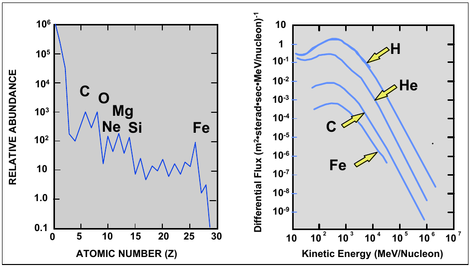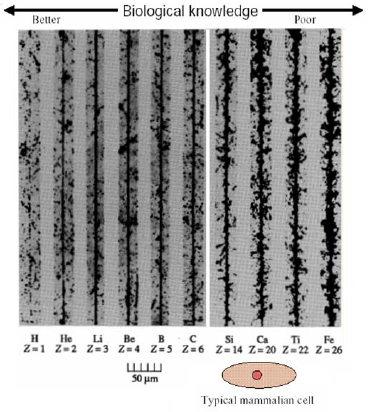Heavy Ions
Heavy ions are charged particles heavier than alpha particles.[1] They constitute 1% of cosmic radiation.[2]
Exposures

The left-hand graph shows which elements make up the heavy ions in cosmic radiation. The right-hand graph shows the distribution of energy levels for 4 ions. For example, carbon is one of the more abundant ions in cosmic radiation, and the most likely kinetic energy level for a carbon ion falls between 100 and 1000 MeV.
Health Effects

The effects of high doses of x-rays and gamma rays have been studied thoroughly by analyzing the health of exposed groups.[5] However, in the case of alpha particles and especially heavy ion radiation, exposures on earth are very rare, and estimates of the risk to astronauts are derived solely from animal model and cell culture studies and application of biophysics principles.[4]
Heavy ions passing through cells transfer more energy into a small volume, compared to other components of cosmic radiation. This concentrated effect can produce qualitatively different types of cell damage.[4]
Linear energy transfer (LET) is a measure of the amount of energy deposited in tissue per unit length of a particle's trajectory.[6] LET increases as a function of ion charge, and decreases as a function of velocity.[7] Experimental irradiation of mouse cell cultures has indicated that heavy ions with an LET greater than 10 keV/μm are more likely to cause irreparable cell damage, compared to protons or alpha particles.[8]
LET has historically been used to estimate relative biological effectiveness (RBE), which is a measure of how harmful radiation is, as compared to the same dose of X-rays or gamma rays. While this estimate might work well for alpha particles (the most common type of high-LET radiation encountered on earth), it might not accurately characterize the damage done by heavy ions. The LET of cosmic radiation ranges up to around 5,000 KeV/um. RBE is considered to peak at around 100 KeV/um; above that it decreases on account of the smaller number of particles per dose. NASA has adopted a new version of the mathematical formula used to estimate RBE (called the "NASA quality factor"), which is designed to produce more accurate estimates for heavy ions.[5]
Shielding Considerations
Heavy ions generate secondary radiation due to the very high energy of the particles. This means the thickness of radiation shielding needs to be increased over the requirements of solar storm shelters. This is particularly a consideration for long term settlements, where the accumulation of radiation damage from inadequate shielding might lead to increased cancer rates, neurological, and tissue damage over time.
References
- ↑ Heavy ion. (1998, Jul 20). In Encyclopaedia Britannica. https://www.britannica.com/science/heavy-ion
- ↑ Schimmerling W. (2011, Feb 5). The Space Radiation Environment: An Introduction. https://three.jsc.nasa.gov/concepts/SpaceRadiationEnviron.pdf
- ↑ Schimmerling W. (2011, Feb 5). The Space Radiation Environment: An Introduction. https://three.jsc.nasa.gov/concepts/SpaceRadiationEnviron.pdf
- ↑ 4.0 4.1 4.2 Cucinotta FA, Durante M. (2009). Risk of Radiation Carcinogenesis. In Human Health and Performance Risks of Space Exploration Missions. NASA-SP-2009-3405. https://humanresearchroadmap.nasa.gov/Evidence/reports/EvidenceBook.pdf
- ↑ 5.0 5.1 Goodhead DT. (2018, Jun 8). Track Structure and the Quality Factor for Space Radiation Cancer Risk. https://ntrs.nasa.gov/search.jsp?R=20180006105
- ↑ Wagenaar JD. (1995, Oct 6). Linear Energy Transfer. In Radiation Physics Principles (Section 7.2.3). http://www.med.harvard.edu/JPNM/physics/nmltd/radprin/sect7/7.2/7_2.3.html
- ↑ Wagenaar JD. (1995, Oct 6). Stopping Power. In Radiation Physics Principles (Section 7.1.2). http://www.med.harvard.edu/JPNM/physics/nmltd/radprin/sect7/7.1/7_1.2.html
- ↑ Wilson JW, Cucinotta FA, Thibeault SA, Kim M-H, Shinn JL, & Badavi FF. (1997, Dec). In JW Wilson, J Miller, A Konradi, & FA Cucinotta, (Eds.), Shielding Strategies for Human Space Exploration (pp. 109-149). NASA Conference Publication 3360. http://hdl.handle.net/2060/19980137598






